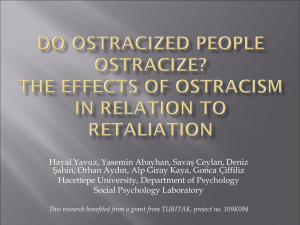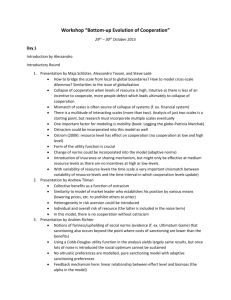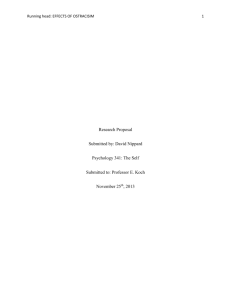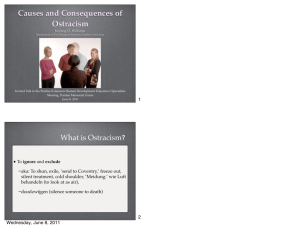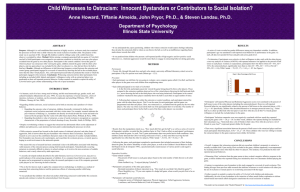Research Journal of Applied Sciences, Engineering and Technology 6(14): 2535-2537,... ISSN: 2040-7459; e-ISSN: 2040-7467
advertisement
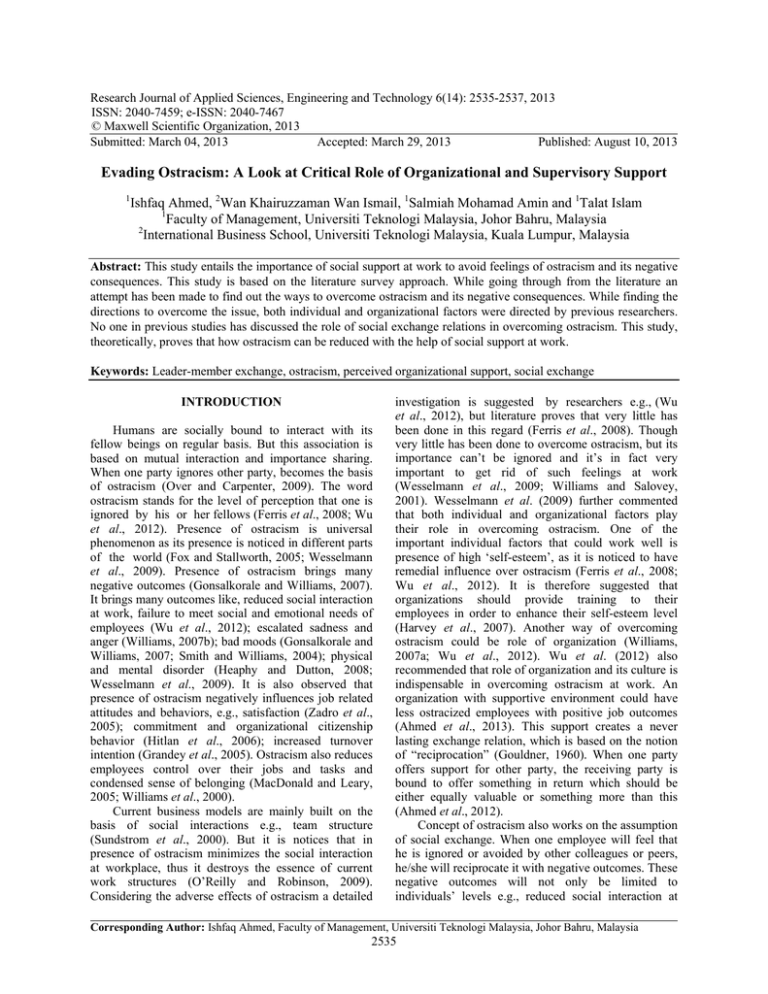
Research Journal of Applied Sciences, Engineering and Technology 6(14): 2535-2537, 2013 ISSN: 2040-7459; e-ISSN: 2040-7467 © Maxwell Scientific Organization, 2013 Submitted: March 04, 2013 Accepted: March 29, 2013 Published: August 10, 2013 Evading Ostracism: A Look at Critical Role of Organizational and Supervisory Support 1 Ishfaq Ahmed, 2Wan Khairuzzaman Wan Ismail, 1Salmiah Mohamad Amin and 1Talat Islam 1 Faculty of Management, Universiti Teknologi Malaysia, Johor Bahru, Malaysia 2 International Business School, Universiti Teknologi Malaysia, Kuala Lumpur, Malaysia Abstract: This study entails the importance of social support at work to avoid feelings of ostracism and its negative consequences. This study is based on the literature survey approach. While going through from the literature an attempt has been made to find out the ways to overcome ostracism and its negative consequences. While finding the directions to overcome the issue, both individual and organizational factors were directed by previous researchers. No one in previous studies has discussed the role of social exchange relations in overcoming ostracism. This study, theoretically, proves that how ostracism can be reduced with the help of social support at work. Keywords: Leader-member exchange, ostracism, perceived organizational support, social exchange INTRODUCTION Humans are socially bound to interact with its fellow beings on regular basis. But this association is based on mutual interaction and importance sharing. When one party ignores other party, becomes the basis of ostracism (Over and Carpenter, 2009). The word ostracism stands for the level of perception that one is ignored by his or her fellows (Ferris et al., 2008; Wu et al., 2012). Presence of ostracism is universal phenomenon as its presence is noticed in different parts of the world (Fox and Stallworth, 2005; Wesselmann et al., 2009). Presence of ostracism brings many negative outcomes (Gonsalkorale and Williams, 2007). It brings many outcomes like, reduced social interaction at work, failure to meet social and emotional needs of employees (Wu et al., 2012); escalated sadness and anger (Williams, 2007b); bad moods (Gonsalkorale and Williams, 2007; Smith and Williams, 2004); physical and mental disorder (Heaphy and Dutton, 2008; Wesselmann et al., 2009). It is also observed that presence of ostracism negatively influences job related attitudes and behaviors, e.g., satisfaction (Zadro et al., 2005); commitment and organizational citizenship behavior (Hitlan et al., 2006); increased turnover intention (Grandey et al., 2005). Ostracism also reduces employees control over their jobs and tasks and condensed sense of belonging (MacDonald and Leary, 2005; Williams et al., 2000). Current business models are mainly built on the basis of social interactions e.g., team structure (Sundstrom et al., 2000). But it is notices that in presence of ostracism minimizes the social interaction at workplace, thus it destroys the essence of current work structures (O’Reilly and Robinson, 2009). Considering the adverse effects of ostracism a detailed investigation is suggested by researchers e.g., (Wu et al., 2012), but literature proves that very little has been done in this regard (Ferris et al., 2008). Though very little has been done to overcome ostracism, but its importance can’t be ignored and it’s in fact very important to get rid of such feelings at work (Wesselmann et al., 2009; Williams and Salovey, 2001). Wesselmann et al. (2009) further commented that both individual and organizational factors play their role in overcoming ostracism. One of the important individual factors that could work well is presence of high ‘self-esteem’, as it is noticed to have remedial influence over ostracism (Ferris et al., 2008; Wu et al., 2012). It is therefore suggested that organizations should provide training to their employees in order to enhance their self-esteem level (Harvey et al., 2007). Another way of overcoming ostracism could be role of organization (Williams, 2007a; Wu et al., 2012). Wu et al. (2012) also recommended that role of organization and its culture is indispensable in overcoming ostracism at work. An organization with supportive environment could have less ostracized employees with positive job outcomes (Ahmed et al., 2013). This support creates a never lasting exchange relation, which is based on the notion of “reciprocation” (Gouldner, 1960). When one party offers support for other party, the receiving party is bound to offer something in return which should be either equally valuable or something more than this (Ahmed et al., 2012). Concept of ostracism also works on the assumption of social exchange. When one employee will feel that he is ignored or avoided by other colleagues or peers, he/she will reciprocate it with negative outcomes. These negative outcomes will not only be limited to individuals’ levels e.g., reduced social interaction at Corresponding Author: Ishfaq Ahmed, Faculty of Management, Universiti Teknologi Malaysia, Johor Bahru, Malaysia 2535 Res. J. Appl. Sci. Eng. Technol., 6(14): 2535-2537, 2013 work, failure to meet social and emotional needs of employees (Wu et al., 2012); escalated sadness and anger (Williams, 2007b); bad moods (Gonsalkorale and Williams, 2007; Smith and Williams, 2004); physical and mental disorder (Heaphy and Dutton, 2008; Wesselmann et al., 2009); but organization also suffers with negative consequences e.g., reduced satisfaction (Zadro et al., 2005); reduced commitment and organizational citizenship behavior (Hitlan et al., 2006); and increased turnover intention (Grandey et al., 2005). While looking at ways to overcome ostracism both individual and organizational factors are considered equally significant; but Wu et al. (2012) highlighted that the role of organization is many fold. Considering the social exchange relations, it is believed that when employees feel that they are ignored by their peers, other exchange relations should come alive to cover the deficiency. While looking at the exchange relations at work (Ahmed et al., 2012) found that there are three basic exchange relations present at work place i.e., employee-employee exchange relation (co-worker’s support), employee-supervisory exchange relation (LMX) and employee-organization exchange relation (POS). When we look at the essence of ostracism, it could be concluded that ostracism is actually absence of co-workers’ support at work. But its effects can be reduced by provision of other social supports i.e., LMX and POS. When organization or leadership will provide support, employees will attach themselves to the organization or their leader. Which will reduce their ostracized outcomes and they will feel protected. As organization and its leadership settles the culture for their organization; provision of such supports will also create culture of support and thus it will reduce employees’ attitude of ignoring others. Thus both organizational support and leaders support will create a culture of support and will reduce the chances of presence of ostracism at work. Thus it could be inferred that provision of POS and LMX will have two fold outcomes; one is the creation of supportive culture which will reduce ostracism at work; and second, it will reduce employees’ feelings of being ignored and they will feel that they are protected. Thus the discussion presented in above sections tells that ostracism could be overcome with the help of social support at work. CONCLUSION AND DISCUSSION This research endeavor is aimed to find out ways to deal with ostracism and its negative outcomes. This research study entails the role of social support at work. There are three social exchange relations at work i.e., co-worker support relation, leader-member exchange relation and perceived organizational support relation. Ostracism is actually presence of one exchange relation i.e., co-worker support relation. The best way to overcome presence of an exchange relation is to strengthen the other social exchange relations. The discussion proves that Provision of Support from organization (POS) and Leader (LMX) reduces the presence of ostracism by two ways. One, such support creates a culture of support and positive exchange which covers the co-workers exchange relations; thus changes of ostracism or being ostracized are minimized. The second action is through creation of attachment with the supervisor and organization, which reduces the feelings of being ignored and control. Thus both POS and LMX could work as remedial measure to overcome ostracism and its adverse effects. IMPLICATIONS AND RECOMMENDATIONS One of the important contribution and implication of this research is to suggest a ways out to overcome ostracism and its negative effects. This study proposes that absence of one social support should be covered with the presence of other social support i.e., POS and LMX. Both these supports will reduce the chances of ostracism as well as they will overcome the adverse effects of ostracism. This study directs that when employees feel ostracized by their peers, their leader and organization should offer them support. This research is merely a discussion based on the literature and sets out new directions for further analysis. This research gives a direction or solution to the problem of ostracism. The solution suggested by this research is new in its nature; thus it still needs to be strengthened by empirical investigation. REFERENCES Ahmed, I., W.K.W. Ismail, S.M. Amin, M. Ramzan and M.K. Khan, 2012. Theorizingantecedents of perceived organizational support: A literature review approach. Middle-East J. Sci. Res., 12(5): 692-698. Ahmed, I., W.K.W. Ismail, S.M. Amin and M.M. Nawaz, 2013. Social exchange perspective of indivdual guanxi network: Evidence from malaysian-chinese employees. Chinese Manage. Stud., 7(1), In Press. Ferris, D.L., D.J. Brown, J.W. Berry and H. Lian, 2008. The development and validation of the workplace ostracism scale. J. Appl. Psychol., 93: 1348-1366. Fox, S. and L.E. Stallworth, 2005. Racial/ethnic bullying: Exploring links between bullying and racism in the US workplace. J. Vocat. Behav., 66: 438-456. 2536 Res. J. Appl. Sci. Eng. Technol., 6(14): 2535-2537, 2013 Gonsalkorale, K. and K.D. Williams, 2007. The KKK won't let me play: Ostracism even by a despised outgroup hurts. Eur. J. Soc. Psychol., 37(6): 1176-1186. Gouldner, A.W., 1960. The norm of reciprocity: A preliminary statement. Am. Sociol. Rev., 25: 161-178. Grandey, A.A., B.L. Cordeiro and A.C. Crouter, 2005. A longitudinal and multi-source test of the workfamily conflict and job satisfaction relationship. J. Occup. Organ. Psych., 78: 305-323. Harvey, P., J. Stoner, W. Hochwarter and C. Kacmar, 2007. Coping with abusive supervision: The neutralizing effects of ingratiation and positive affect on negative employee outcomes. Leadership Quart., 18: 264-280. Heaphy, E.D. and J.E. Dutton, 2008. Positive social interactions and the human body at work: Linking organizations and physiology. Acad. Manage. Rev., 33: 137-162. Hitlan, R.T., K.M. Kelly, S. Schepman, K.T. Schneider and M.A. Zárate, 2006. Language exclusion and the consequences of perceived ostracism in the workplace. Group Dyn-Theor. Res., 10(1): 56-70. MacDonald, G. and M.R. Leary, 2005. Why does social exclusion hurt? the relationship between social and physical pain. Psychol. Bull., 131(2): 202-223. O’Reilly, J. and S.L. Robinson, 2009. The negative impact of ostracism on thwarted belongingness and workplace contributions. Proceeding of Academy of Management Meeting. Over, H. and M. Carpenter, 2009. Priming third-party ostracism increases affiliative imitation in children. Developmental Sci., 12(3): F1-F8. Smith, A. and K.D. Williams, 2004. R U there? Ostracism by cell phone text messages. Group Dyn-Theor. Res., 8(4): 291-301. Sundstrom, E., M. McIntyre, T. Halfhill and H. Richards, 2000. Work groups: From the Hawthorne studies to work teams of the 1990s and beyond. Group Dyn-Theor. Res., 4: 44-67. Wesselmann, E.D., D. Bagg and K.D. Williams, 2009. I feel your pain: The effects of observing ostracism on the ostracism detection system. J. Exp. Soc. Psychol., 45(6): 1308-1311. Williams, K.D., 2007a. Ostracism. Ann. Rev. Psychol., 58: 425-452. Williams, K.D., 2007b. Ostracism: The kiss of social death. Soc. Pers. Psychol. Comp., 1(1): 236-247. Williams, K.D. and P. Salovey, 2001. Ostracism: The Power of Silence. Guilford Press, New York. Williams, K.D., C.K. Cheung and W. Choi, 2000. Cyberostracism: Effects of being ignored over the internet. J. Pers. Soc. Psychol., 79(5): 748-762. Wu, L.Z., F.H.K. Yim, H.K. Kwan and X. Zhang, 2012. Coping with workplace ostracism: The roles of ingratiation and political skill in employee psychological distress. J. Manage. Stud., 49(1): 178-199. Zadro, L., K.D. Williams and R. Richardson, 2005. Riding the 'O' train: Comparing the effects of ostracism and verbal dispute on targets and sources. Group Process. Interg., 8(2): 125-143. 2537
